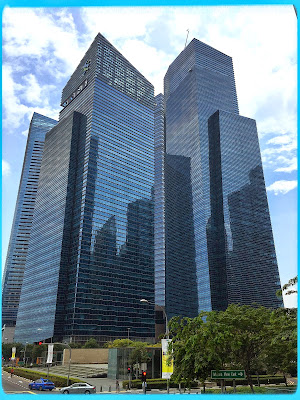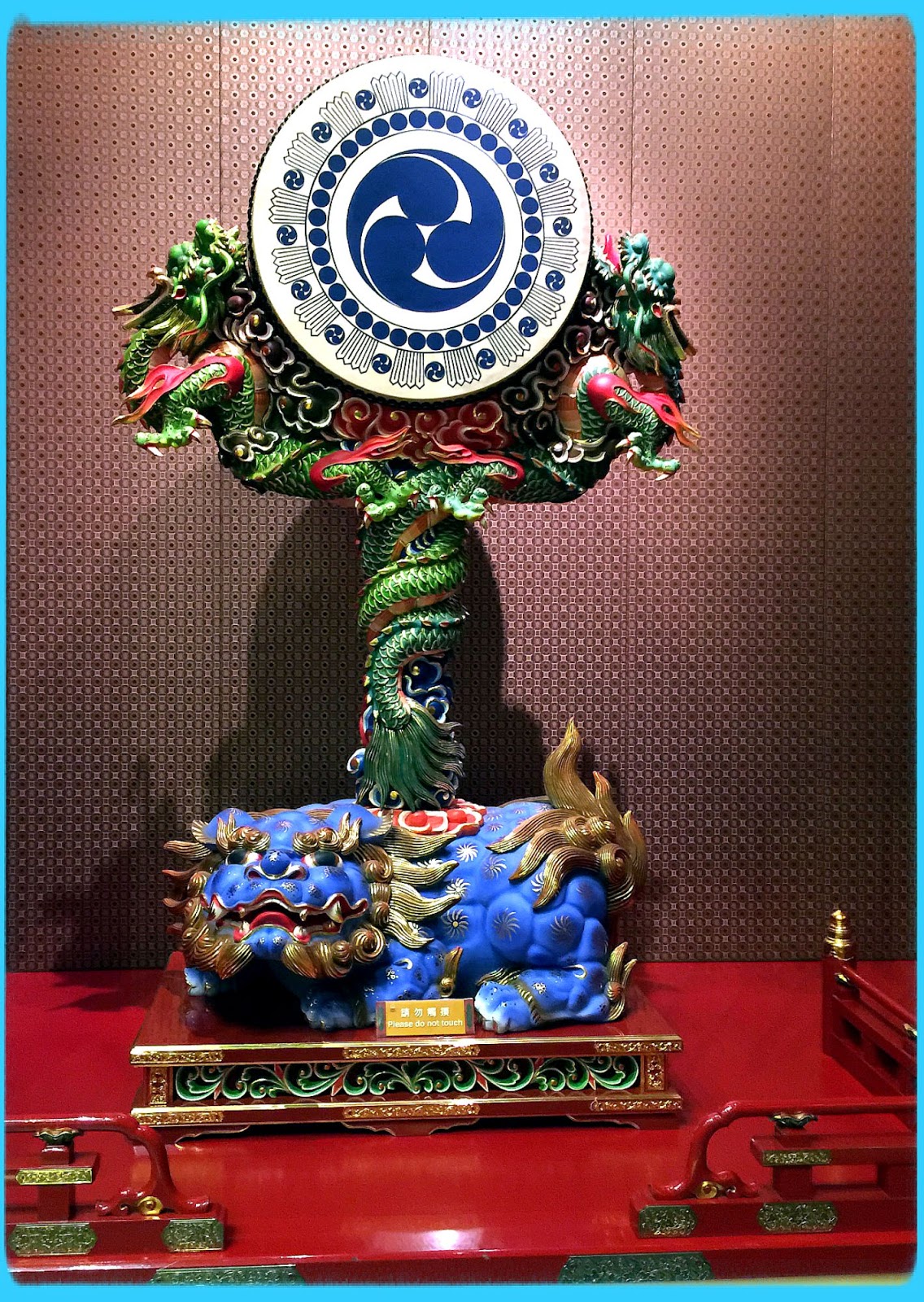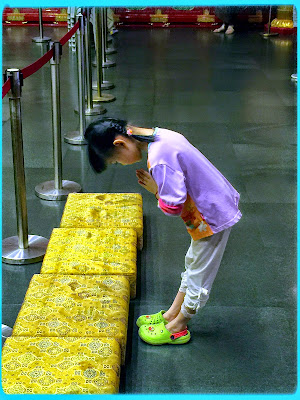Singapore! This was a port I had heard so much about with descriptions such as beautiful, efficient and clean to too many laws, expensive and ever changing. It would also be a port that held many memories for our traveling companion and dear friend Frank during his years in the Royal Air Force. So this post is written with him in mind and I hope to do it justice.
As we reached Singapore, we had officially traveled 3,413 nautical miles from Yokohama over twelve days. Singapore would mark the beginning of the second portion of our cruise which was taking us further south to Australia over nineteen more days on the same ship.
During the early morning hours, the Diamond Princess embarked a local pilot and set a course through various water traffic separation schemes. We left Pulau Batam, part of Indonesia, and set westerly courses throughout the busy waters of the Singapore Straits where we came to dock at the Singapore Cruise Centre.
The "all clear" was given close to 7:00 a.m. and passengers were then allowed to go ashore. It was a partly cloudy day with temperatures hovering around 82F (28C), high humidity and on again/off again showers throughout the day.
The Singapore Dollar (SGD) reigns in this city with an exchange rate of approximately 1 SGD to 70 cents US at the time. English is one of four official languages in Singapore with Malay, Mandarin and Tamil being the other three. Now, in case you are wondering "where in the world is Singapore?", I've got you covered...with a nod of thanks to the world atlas.

Before we begin, it helps to know a little about our host destination. Singapore is a city of constant growth with lots of modern, unique structures. In the third century, its name Pu-Lou-Chong meant "island at the end of a peninsula". Later, the city was known as Temasek, or "sea town", when the first settlements established around AD 1298-1299. It was not until the 14th century when, according to legend, a Prince from Palembang (capital of Srivilaya on the island of Sumatra) was out hunting and saw an animal he had never seen before. Seeing it as a sign of good luck, he founded a city where he spotted the animal. That city he named Singapura, or "the lion city". Ruled by five kings, the city prospered as a natural meeting point for sea routes and thus became a strategic location for trade for a wide variety of ocean vessels from China, India, Arabia, Portugal and Indonesia. During the 19th century, modern Singapore came alive. Already a popular trading post, Great Britain saw a need for a port of call in this region. The merchant fleet of this growing empire needed a base for British traders. Believe it or not, Singapore was still mostly a swamp covered island at the time. Sir Thomas Stamford Raffles, the Lieutenant Governor on Sumatra at the time, saw potential in Singapore and aided in the negotiation of a treaty with local rulers and established Singapore as a trading station. After World War II, the Japanese occupied the island for three and a half years. In 1945 after the Japanese surrendered, the island was handed over to the British Military Administration and the following year it became a Crown Colony of Great Britain. Then in 1965, Singapore became an independent nation with the current ruling party known as the People's Action Party (PAP).
Now here we are - back to where we began. Let's explore Singapore!
We planned our day using the HOHO, or "Hop On, Hop Off" double decker bus system. It is a great way to see the sights and gives the flexibility of choosing where and when you want to "hop off" and "hop back on" again.
Not far from the port was the Marina Area. This was home to the "Singapore Flyer", a large ferris wheel.
Also located in the Marina Area was the Marina Bay Sands Hotel, owned by the Las Vegas Sands company. As we left the Marina Area, we had a great view of the hotel and what looked like a ship sitting on top of it. This "ship" was actually a garden/pool area called the Sky Tower where a famous infinity pool was located. The pool itself juts up against glass on the outer edge of the "ship" which offers an unobstructed view straight over the side of the hotel.
Heading towards the city, we had great views of the skyline with its ultra modern structures.
We crossed the Singapore River and left behind us the newer south bank of the river. Off in the distance we caught a view of a giant concrete lotus blossom, home to the ArtScience Museum. This museum is an attraction that is part of the Marina Bay Sands Hotel. Thinking progressive: rainwater is harvested and channeled down the center of the building then flows through its bowl shaped roof into a reflecting pond at the lower level. The rainwater is then recycled and used in the building's restrooms. I found that very unique.
Next we ventured into the River Valley area near Clark's Quay. There I spotted the colorful shutters of the Hillstreet Building, the colors being a celebration of the diverse ethnic population of Singapore.
This message from the Public Transit Council used "Stand-Up Stacey" to remind bus passengers of good manners. I liked it.
Many visually stunning buildings and such unique architecture displayed in Singapore.
The 80+ year old Quadrant at Cecil Building, a gateway to Singapore's financial centre.
The Cenotaph at War Memorial Park honors the heroes who fought and died during World War I and World War II.
 Simply loved the colors, creativity and cleanliness in most parts of this city.
The Suntec Singapore Convention and Exhibition Centre was located in downtown Singapore and opened in July, 1997. The emphasis during construction was on Chinese geomancy, or feng shui as many would know it as. Suntec consists of five buildings and a convention centre which was designed to look like a left hand when viewed from the air.
Also, this "Fountain of Wealth" was made of bronze specifically because it is believed that metal and water combined pave the way for success. From the air, the fountain appears as a golden ring in the centre of the left hand.
A commercial building known as the Shaw Towers was being constructed.
The domed Old Supreme Court Building was the last structure built in the classic architectural style in the former British Colony. It was constructed in front of the historical Padang grounds, which used to be known as the Padang Cricket Ground.
We drove past the gorgeous pastel colors of the Clarke Quay Traders' Market where vendors hawk eco-friendly products like handmade arts and crafts and "pre loved items" all in the spirit of recycling.
The Raffles Hotel, a five-star luxury retreat, was named after Sir Thomas Stamford Raffles (mentioned earlier), the founder of modern Singapore. This hotel is rich in history and used to house a museum, which unfortunately closed in 2012.
Magnificent courtyard at the Raffles Hotel.
Simply loved the colors, creativity and cleanliness in most parts of this city.
The Suntec Singapore Convention and Exhibition Centre was located in downtown Singapore and opened in July, 1997. The emphasis during construction was on Chinese geomancy, or feng shui as many would know it as. Suntec consists of five buildings and a convention centre which was designed to look like a left hand when viewed from the air.
Also, this "Fountain of Wealth" was made of bronze specifically because it is believed that metal and water combined pave the way for success. From the air, the fountain appears as a golden ring in the centre of the left hand.
A commercial building known as the Shaw Towers was being constructed.
The domed Old Supreme Court Building was the last structure built in the classic architectural style in the former British Colony. It was constructed in front of the historical Padang grounds, which used to be known as the Padang Cricket Ground.
We drove past the gorgeous pastel colors of the Clarke Quay Traders' Market where vendors hawk eco-friendly products like handmade arts and crafts and "pre loved items" all in the spirit of recycling.
The Raffles Hotel, a five-star luxury retreat, was named after Sir Thomas Stamford Raffles (mentioned earlier), the founder of modern Singapore. This hotel is rich in history and used to house a museum, which unfortunately closed in 2012.
Magnificent courtyard at the Raffles Hotel.
The storied Long Bar at the Raffles Hotel is the home to the Singapore Sling cocktail drink.
Mr. Ngiam Tong Boon, a bartender who worked at the Long Bar, invented the Singapore Sling sometime before 1915. Mr. Boon originally called his drink the "Gin Sling". So, "when in Rome"...I tried the cocktail made with gin, grenadine and sweet and sour mix...it was very sweet and not really my style. The hard part to swallow though was the price. It cost us $40.60 US for one bottle of Corona (Rick) and one Sling (me)!!!!!!!! Unbelievable! Singapore lived up to its reputation of being a very expensive place to live just in one bar bill.
The rich wood decor of the Long Bar was beautiful...if only that wood could talk. Over the decades, this bar has hosted famous icons such as Ernest Hemingway and William Somerset Maugham.


After visiting Raffles, we waited for our HOHO bus to pick us up. At the bus stop I saw a Snow Miku wrapped bus. These special buses ran from October 3 - December 25, 2014 and there were only ten of them in Singapore. "Snow Miku 2015" art was wrapped on one side of the bus and original art of Hatsune Miku wrapped the other side (couldn't see that side, unfortunately). Hatsune Miku is a young girl with turquoise pigtails whose voice is made from a very advanced vocal synthesizer (as I have mentioned before in my previous posts from my visit to Japan, the Japanese cartoon is an amazing form of art and is followed with adoration by its many fans). These buses are gorgeous ads for a winter festival held every year since 2010 in Sapporo, Hokkaido (Japan). Sapporo is the home of Crypton Future Media, Inc., the creators of Hatsune Miku. Every year, Crypton Future Media Inc. chooses different countries to host their ads.

Although we never eat at these locations, it is always fun to check out the local McDonalds or fast food joints in other countries to see just how different their menus are from back home. This McDonalds is proud to announce that their EBI Burger is back! This "burger" is a whole shrimp patty that comes with Wasabi sauce. Instead of "biggy sizing it" as in the US, this came as a "feast" with seaweed shaker fries. Another difference was the White Peach McFizz drink and the mango pocket pie (the US only offers apple).

We stopped in Chinatown and visited the Buddha Tooth Relic Temple and Museum. When entering the temple, wraps were provided for visitors wearing shorts that fell above the knees. Covering your bare legs with the wrap was a show of respect as was silence and no flash photography. The interior rooms were vibrant with color and very ornate. If you are wondering whether there really is a "tooth relic" in the temple, the answer is "yes". This temple was constructed to house the tooth relic of Buddha after it was claimed to be found in 1980 in a collapsed Buddhist shrine in Burma.
The sweetest thing was to witness this adorable little girl conducting her prayers.
Our bus took us through the Tanjong Pagar, a historic district that used to be a fishing village. Located between the docks and the town, it was a haven for Chinese and Indian dock workers who migrated to Singapore during the mid-19th century. The area became famous for rickshaw pullers, which were so abundant that in 1904 the government established the Jinrickha Station to help organize the traffic. The station still stood at the juncture of Tanjong Pagar Road and Neil Road (photo on right) although the rickshaw population was gone. The eventual demise of this district came with overcrowding, pollution, opium and prostitution. It has since been revived and the mix of old, restored shophouses next to super modern structures seemed harmonious side by side.
Chinatown shophouses - businesses on the first floor with residences above the shops.
Tailor shops and unusual items were abundant in this pedestrian mall.
Hawker Centers in Singapore are very popular. They can be compared to the concept of "food courts" back home only more variety and better quality along with inexpensive price tags. A traditional dish in Singapore is called Laksa and consists of noodles, fishcake, prawns, cockles and chopped bean sprouts served in a spicy, coconut based soup. Chilli crab is another popular dish made with mud crabs stir fried in semi-thick, sweet tomato and chilli based sauce.
As if Singapore wasn't expensive enough, it even had a pricier district called Orchard Road. We arrived before Christmas so the boulevard was decorated in a galaxy of colorful stars. Known as simply "Orchard" by locals, this 1.37 mile long (2.2 km) road sports high end designer shops, swanky cafes and restaurants.
Outram Road runs through the Outram district, a prominent business centre. Outram Road was named in 1858 after Sir James Outram, a British general during the Indian Rebellion of 1857.
Eventually, we made our way back to the ship on the bus. It had been a full day of sightseeing and we were exhausted. Along the ride back, I learned some more interesting tidbits about Singapore:
E.R.P. (Electronic Road Pricing) is the automatic toll collection system in Singapore that most modern cities use today. Singapore was the first city in the world to adopt this system in an aid to ease traffic congestion
Vehicle ownership in Singapore is EXPENSIVE! Aside from owning a vehicle, the owner must bid at auction for a Certificate of Entitlement which gives them the right to register, own and use a vehicle for a period of ten years. The costs for these certificates can range from about $3,500 for a motorcycle to over $100,000, depending on the class of the vehicle. Sometimes the cost of the certificate is more than the vehicle itself.
Singapore is a land of very strict laws (we were careful to familiarize ourselves with them before we went ashore). Here are a few: forget to flush the toilet and face a public caning; littering can cost $1,000 for your first offense and $5,000 for a second offense; selling and chewing gum is forbidden; no hugging in public without the other person's permission; drug trafficking is a death penalty; Urine Detection Devices (UDD) are equipped in all elevators to detect the scent of urine which then sets off an alarm, doors automatically close and the offender is held until police arrive (there is an obvious moral to this story and one we didn't have to worry about).
That night at 6:00 p.m., the Diamond Princess set sail once again to far away lands. We stood on the deck and watched the sun set over the Singapore skyline.
Visit with me to our next port of call (Thailand) by clicking on this link: Asia and Australia 2014




































































No comments:
Post a Comment